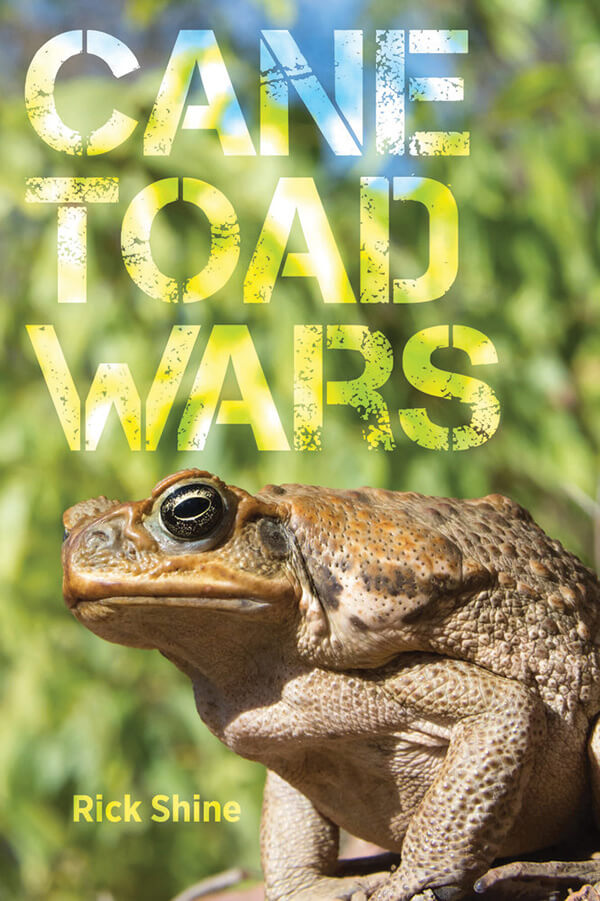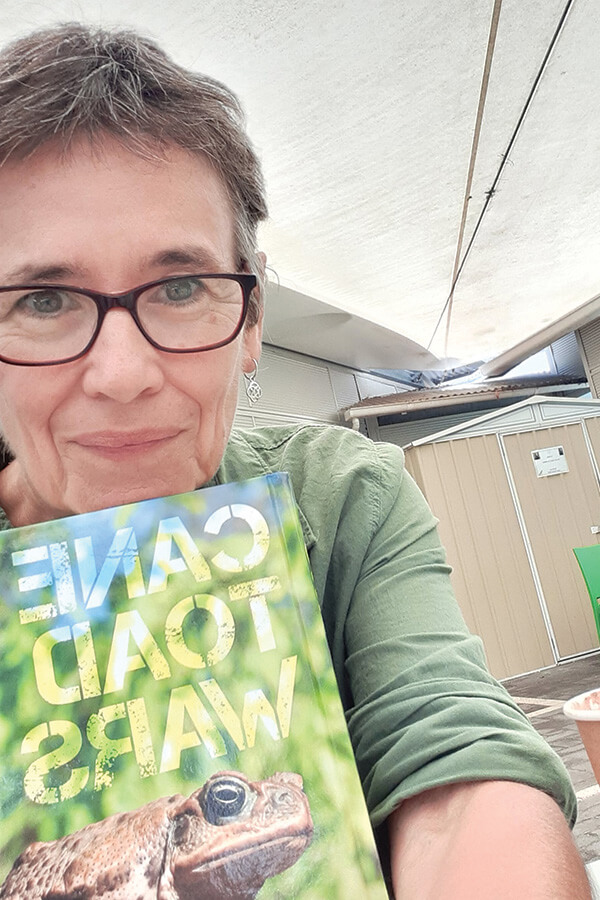
I haven’t done a book review before because I haven’t been asked to, and also I haven’t been moved to, until now. I have heard the name Rick Shine many times in the world of amphibian research, but this graceful, humane and humorous literary creation, Cane Toad Wars, is the first one I have read. I found myself awakened, delighted, seeking more and chuckling my way through this book.
As a child with several older brothers and sisters, I unconsciously joined in with cruel acts on Cane Toads in country Samford because they were there, they were ugly and it was permissible. Also because we had an air-gun rifle and enjoyed any opportunity to use it, especially on something that would reward us with a hunter’s thrill of domination. Later I stumbled into my more conscious, adult ‘Dettol’ era. This thankfully was remarkably short-lived for reasons of horror at the sight of squirming, tortured toads, an opposite effect to what many people believed and promoted.
From an early age we all get a strange buzz out of hating something; broccoli, our hair, ‘You’re not my friend anymore’, traffic… Cane Toads. As Rick explains, the ‘disgustingness’ of Cane Toads is our own making and, in other countries, people are actually fond of them. What!! They may not be what we believe them to be?!
Over the past two decades as an observer of natural processes, as a frogger, and as a rural landholder with a desire for a fair go for natives, I have reviewed the human psychology behind Cane Toad control activities. I’ve considered their intention and effectiveness to the point of almost being Zen at the sight of these creatures on my driveway at night and being free from anxiety over their impact on ecosystem co-habitants. I often reflect on how many toads were left to die slowly, for no apparent result, as my Dad still has them skulking under the cover of his pond overflow 50 years later.
Rick puts words easily alongside my reasoning. He writes personally and relates his experiences as a field and laboratory scientist to a broader world. He provides a Cane Toad history in Australia and other parts of the world that exposes our ignorance and arrogance when we mess with species and natural processes. With kind humour he relieves us from an obsession of knowing all the answers, while providing factual insight and understanding that may help us make an informed and humane difference.
 Most of us would understand that the Cane Toad has had a massive impact on native species in eastern and northern Australia due to its extremely potent poison created for defence. It’s no happy sight to see a dead goanna or snake after a meal of Cane Toad. However, it’s equally uplifting to hear of the myriad of animals that have been observed successfully dining on them (see list below), alongside the common emaciation of toads due to disease and parasites. I am grateful that Rick promotes the understanding that toads have placed evolutionary pressures on our native wildlife forcing them to either adapt and build resilience or perish. Thankfully, most native vertebrates have adapted to some degree. Similarly, I would agree with his suggestions that other human impacts on ecosystems are phenomenally more dramatic that this one impactful species.
Most of us would understand that the Cane Toad has had a massive impact on native species in eastern and northern Australia due to its extremely potent poison created for defence. It’s no happy sight to see a dead goanna or snake after a meal of Cane Toad. However, it’s equally uplifting to hear of the myriad of animals that have been observed successfully dining on them (see list below), alongside the common emaciation of toads due to disease and parasites. I am grateful that Rick promotes the understanding that toads have placed evolutionary pressures on our native wildlife forcing them to either adapt and build resilience or perish. Thankfully, most native vertebrates have adapted to some degree. Similarly, I would agree with his suggestions that other human impacts on ecosystems are phenomenally more dramatic that this one impactful species.
To read Cane Toad Wars is to become more respectful and humble to the power of natural processes and to review our place in the infinite complexity around us. Hopefully, while we ponder the impact of the Cane Toads, we will also review our own. This book will go on my bookshelf as one of the fully read works that is likely be retrieved again and again for reference. Thank you Rick.
Who eats Cane Toads?
- Several species of spiders eat toad tadpoles
- Some water scorpions and dragonfly larvae eat toad eggs and tadpoles
- Freshwater crayfish
- Saw-shell and Krefft’s Turtles
- Keelback and Red-bellied Black Snakes
- Kookaburras and kingfishers
- Crows and ravens
- Ibis, egrets and herons
- Butcherbirds and magpies
- Giant White-tailed Rats and the Water Rat (Rakali)
Eva Ford
Land for Wildlife member
Traveston, Gympie
